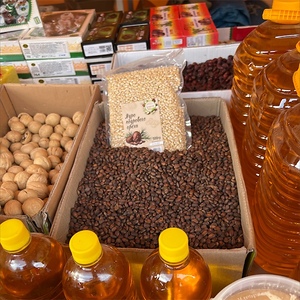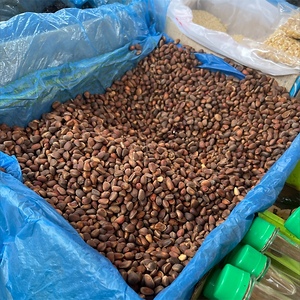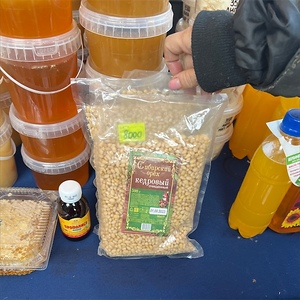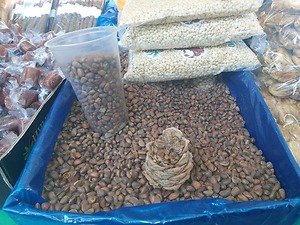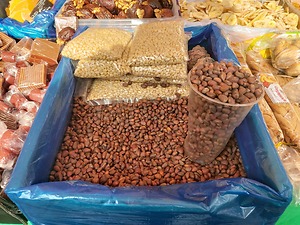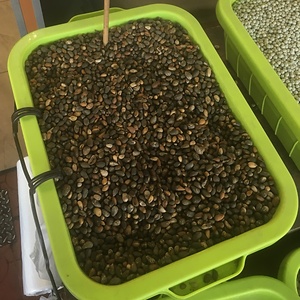

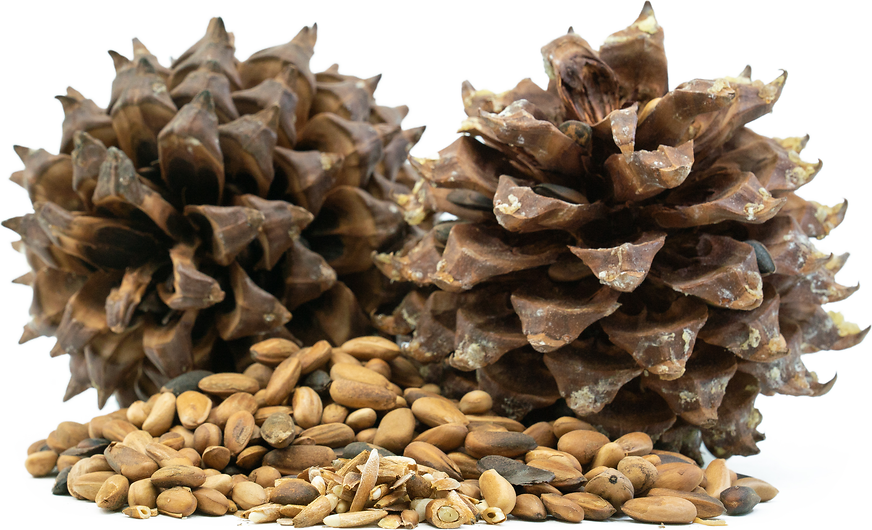
Foraged Pine Nuts
Estimated Inventory, lb : 0
Description/Taste
Pine nuts form within the scales of a pine cone. Each cone contains 1 to 2 nuts tucked inside the cones' spiny, hard-shelled scales. The small tear-shaped nuts are about 10 to 12 millimeters wide and 20 to 25 millimeters long. They possess a thin, multi-colored shell with amber and chocolate hues, which, when peeled away, exposes the ivory-toned interior. Pine nuts have a smooth surface and exhibit a firm but slightly soft texture with a lightly oily feel. They have a mild, sweet, and nutty aroma with a hint of resinous pine, especially when fresh. They emit a warm, toasted, rich, buttery fragrance when roasted. Pine nuts have a somewhat meaty, savory flavor with a touch of starchiness. Their taste is sweet and complex, with hazelnut, maple, and fig notes. When roasted, Pine nuts unveil a soft, buttery taste comparable to cashews and macadamia nuts.
Seasons/Availability
Pine nuts are traditionally harvested when a pine cone reaches its maturity in late summer and early fall.
Current Facts
Pine nuts are the edible seeds of the pine family known as Pinaceae. Within the Pinaceae family are several species, among which Pinus coulteri, also known as Coulter pine or Big Cone pine, is among the most common. Pine nuts are mainly used in cooking, but they also have medicinal applications attributed to their anti-inflammatory and antioxidant effects. These effects can be attained by eating them raw, cooked, or as a pureed paste. Pine nuts originate from diverse regions, including Europe, Russia, Siberia, Central Asia, China, and North America. They are produced by various pine tree species, with popular varieties such as the Stone pine, Piñon pine, Single-Leaf piñon, and Korean pine. Among these, the Korean pine is the most exported worldwide. Pine nuts have played a prevalent role in various cultural cuisines worldwide, and factors such as climate change, overharvesting, and pest infestations have impacted the supply and pricing, contributing to their sometimes high cost and reputation as a premium ingredient.
Nutritional Value
Pine nuts offer notable health benefits, such as boosting energy with their protein, iron, and magnesium content. They may also stabilize blood sugar and aid diabetes management by balancing fats and fiber, promoting heart health. Additionally, Pine nuts' high vitamin K and E contents are crucial for bone strength, skin health, and immune function. In Traditional Chinese Medicine, Pine nuts are utilized for alleviating coughs and respiratory ailments by eliminating phlegm. There is a peculiar phenomenon known as "pine mouth” when Pine nuts are consumed. This is when someone who has ingested Pine nuts experiences a metallic and bitter aftertaste when eating food afterward. This rare condition is medically called metallogeusia, and only some individuals will be affected. Luckily, it’s not permanent, lasting anywhere from 2 to 4 weeks.
Applications
Pine nuts can be enjoyed raw and cooked, making them a flexible ingredient for various culinary applications. In their raw form, they can be tossed into a salad, sprinkled on top of dishes, or eaten alone. When cooked, the rich nutty flavor and crunchy texture of Pine nuts enhance various dishes, including pesto, pasta, and baked goods. The versatility of Pine nuts bodes well for recipes both sweet and savory. Pine nuts are also common in Italian, Greek, Lebanese, Spanish, and Turkish cuisines. In Italy, chefs use them to create studded escarole, while Spanish cooks pair them with braised rabbit and fried sole. In Greek and Turkish cuisines, Pine nuts are combined with herbs and rice and stuffed into fresh mussels. They complement ingredients, including dates, brown sugar, and dried fruits such as cherries, apricots, and figs. They also taste great with coffee, maple syrup, molasses, roasted nuts such as pistachios and Marcona almonds, herbs like basil, mint, and arugula, aged hard cheeses, cream, citrus, tomatoes, mushrooms, bacon, and spices such as cumin, coriander, and curry. Fresh Pine nuts should be kept in a sealed container and stored in the refrigerator, where they will keep for 1 to 3 months. When placed in a cool, dry, and room-temperature environment, they can remain fresh for up to a month.
Ethnic/Cultural Info
Pine nuts have been intertwined with various cultures since biblical times. The verse in Hosea 14:8, "I am like a green fir tree. From me is thy fruit found," is believed to reference Pine nuts. Greek and Roman cultures revered pine trees as sacred to the god Neptune. Pine nuts were also consumed and preserved in honey during Pliny's era. Archaeologists even found them in Pompeii's ruins, and Roman legions carried them as provisions, as evidenced by pine nut shells in British Roman encampments dating back to the first century. For over 10,000 years, indigenous tribes in North America, including the Washo, Shoshone, Paiutes, and Hopi, depended on Pine nuts as a fundamental part of their diet. They weren't just a dietary staple; they brought joy and unity, with yearly gatherings and celebrations centered on the harvest. The intricate and imperfect process of harvesting Pine nuts before cone ripening transformed this annual event into a momentous social gathering in the sacred lowland pinyon forests.
Geography/History
Though Pine nuts are grown in many types of climates, they thrive best in dry, arid regions. The trees that produce Pine nuts, mainly varieties of pine trees, are often found in Mediterranean climates as well as the colder mountain regions of the Northern Hemisphere, adapting well to both hot, dry summers and cold winters. Some of the most prosperous varieties of Pine nuts thrive in coniferous forests native to the coastal mountains ranging from California to Baja, Mexico. These trees produce perhaps the largest pine cones within the Pineaceae family. During harvest season, those who work within the Big Cone pine groves are advised to wear hard hats as the trees themselves have been dubbed the ominous name "widowmaker.” The pine cones can weigh up to ten pounds and reach forty centimeters in length. These pine cones are harvested before the cones open, as once they are open, the nuts are vulnerable to nature—specifically squirrels and birds. Pine nuts have a long history in various Northern Hemisphere cultures, and their worldwide use has evolved gradually. Today, they are readily available in grocery stores and farmers' markets. And for those determined to forage, Pine nuts can still be sought out directly from pine trees, although this requires effort, dedication, and consultation with an expert.
Recipe Ideas
Recipes that include Foraged Pine Nuts. One



